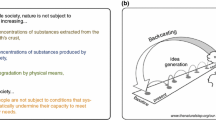Abstract
Eco-efficiency is critical for organisations that seek to be both environmentally conscious and profitable. It helps to “produce more out of less” to avoid wasting natural resources and to reduce emissions and damage to the environment. The textile coating and laminating industry, utilising solvent or water-based polymeric mixtures, is one of the industries coming under extreme environmental pressure to replace traditional procedures and use eco-efficient coating agents. In this study, eco-efficiency analysis was used to compare the eco-effectiveness of two different coating agents, polyacrylate and polyurethane, each in organic solution as well as aqueous dispersion forms. The “ecological fingerprint” and eco-efficiency portfolio were graphically illustrated for these coating agents based on the customer benefit, defined as coating one square meter of a textile fabric in a conventional laminating unit. According to the analysis results, polyacrylate dispersion in water was the most eco-efficient coating agent whilst polyurethane resin dissolved in organic solvent was found as the coating agent with the least acceptability as an eco-efficient product.
Similar content being viewed by others
References
A. Kicherer, H. Pfisterer, November 2000, BASF Aktiengesellschaft Publication, Ludwigshafen, Germany.
Finnish Ministry of Environment, August 2001, taken from http://www.vyh.fi/eng/research/cluster/backrou/Whatecoe.htm.
P. Saling, A. Kicherer, R. Wittlinger, Internat. J. Life Cycle Assess. 6 (2001) 1.
R. Landsiedel, P. Saling, Int. J. LCA 7 (2002) 261.
P. Saling, A. Kicherer, Internat. J. Life Cycle Assess. 7 (2002) 203.
The BASF Eco-efficiencyAnalysis Method, November 1999, Taken from http://www.cc.jyu.fi/helsie/pdf/salinger.pdf.
Electronic Edition of Ullmann’s Encyclopedia of Industrial Chemistry, 5th ed., Wiley-VCH, 1999.
L. Phillip, M.D. Polakoff, NIOSH Health Hazard Report 72-58 September 1973, taken from http://www.ecologycenter.org/iptf/toxicity/pvcmeatwrap.html, 1993.
P.M. Lemieux, International Plastic Task Force, taken from http://www.ecologycenter.org/iptf/toxicity/bantheburn.html, 1997.
S. Forsyth, Medical Waste Incineration is Poisoning Communities, http://www.revolutionmag.com/newrev2/hosptoxart.html.
APME Internet Pages and Information on Life Cycle assessments, Taken from http://www.apme.org/, 2002.
I. Boustead, The Association of Plastics Manufacturers in Europe (APME) Brussels, April 1999.
S. Bengtsson, L. Sjöborg, Akzo Nobel Product Stewardship and Sustainability, 2004.
Author information
Authors and Affiliations
Corresponding author
Rights and permissions
About this article
Cite this article
Bidoki, S.M., Wittlinger, R., Alamdar, A.A. et al. Eco-efficiency analysis of textile coating materials. JICS 3, 351–359 (2006). https://doi.org/10.1007/BF03245958
Received:
Accepted:
Issue Date:
DOI: https://doi.org/10.1007/BF03245958




